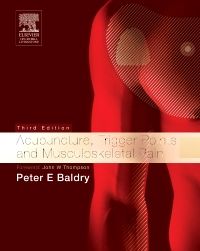The third edition of this highly successful book describes how musculoskeletal pain can be simply and effectively treated by acupuncture. It gives a comprehensive account of current knowledge concerning two very commonly occurring musculoskeletal pain disorders - the myofascial trigger point pain syndrome and the fibromyalgia syndrome. Myofascial trigger point pain syndrome is an all too common complaint. It often goes unrecognised or alternatively is passed off as trivial and ineffectively treated. This third edition gives a wide ranging review of current knowledge concerning it. The author, after having given a detailed account of the neurophysiology of pain in general, discusses at length the pathophysiology of myofascial trigger point nociceptive pain and the rationale for alleviating it by means of the acupuncture technique of superficially applied dry needle - evoked nerve stimulation at trigger point sites.
New to this edition
5 new chapters
Each chapter has been thoroughly revised with fully updated references
Includes all relevant clinical trial information
Part 3 includes information on a wide range of topics such as migraine, laterial epidondylalgia, repetitive strain injury, whiplash and pelvic floor pain disorders
Key Features
- Evidence-based, up-to-date, and detailed information on trigger points, musculoskeletal pain, and the physiology of pain provide the most authoritative assessments available on this topic.
- Practical, step-by-step treatment guidelines help readers apply key concepts to actual practice.
- Clear illustrations demonstrate important techniques and areas of pain and needling.
- Expanded coverage of fibromyalgia and the neurophysiology of myofascial trigger points includes common symptoms and treatments.
- More information on new treatment options for the common problem of whiplash injuries.
Author Information
By Peter E. Baldry, MB FRCP, Emeritus Consultant Physician and Postgraduate Clinical Tutor, Ashford Hospital, London, UK; Member of the British and Irish Chapter of the International Association for the Study of Pain and Member of the International Myopain Society
Introduction
PART ONE Acupuncture - a historical review.
Traditional Chinese acupuncture. How news of acupuncture and moxibustion spread from China to the outside world. The practice of acupuncture in the Western world during the 19th century
PART TWO Principles of trigger point acupuncture
Some basic observations leading to its development. Evolution of knowledge concerning syndromes for which it is employed. Neurophysiology of pain. Myofascial trigger point pain and fibromyalgia syndromes. Concurrent complex regional and myofascial trigger point pain syndromes. Neurophysiological pain - suppressing effects of acupuncture and transcutaneous electrical nerve stimulation. Treatment of myofascial trigger point pain and fibromyalgia syndromes. Scientific evaluation of acupuncture's ability to relieve nociceptive pain.
PART THREE The practical application of trigger point acupuncture.
Chest pain. The painful shoulder. Pain in the neck. Pain in the arm. Pain in the head and face. Low-back pain. Pain in the lower limb. Pain in and around joints. Abdominal and pelvic pain.
Index
"This book provides an excellent, lucid, and westernized approach to one school of acupuncture. I commend it to Physiotherapists, rheumatologists, and general practitioners who are interested in all aspects of musculoskeletal disease."Tha Lancet
a well written, scholarly book which I find of considerable benefit in its description of the anatomy and mechanism of trigger point activity. He diagrams of muscle structure and trigger point location are excellent. … should be regarded as a "must" for those involved or interested in trigger points and musculoskeletal pain."The European Journal of Oriental Medicine
a welcome addition to the pain literature…. Dr Baldry's intention is to place acupuncture within the framework of known mechanisms of pain physiology, provide a scientific foundation for its use, and promote its inclusion in the management of certain pain syndromes… The book is recommended for those familiar with either acupuncture or with myofascial pain syndromes, and who wish to broaden their perspective of the treatment of these conditions"Journal of Musculoskeletal Pain
continue to be impressed by the scope of this book with its extensive range of references from many different sources. The second edition brilliantly joins together the ancient craft of acupuncture with current scientific understanding of the needle effect. It is copiously illustrated throughout with clear line drawings which, together with the text, provide a practical guide for clinical use. It also contains sufficient theory and historical background to allow a broad overview of the subject. This book remains required reading for all who are concerned with needling techniques and the treatment of musculoskeletal disorders"Acupuncture in Medicine














